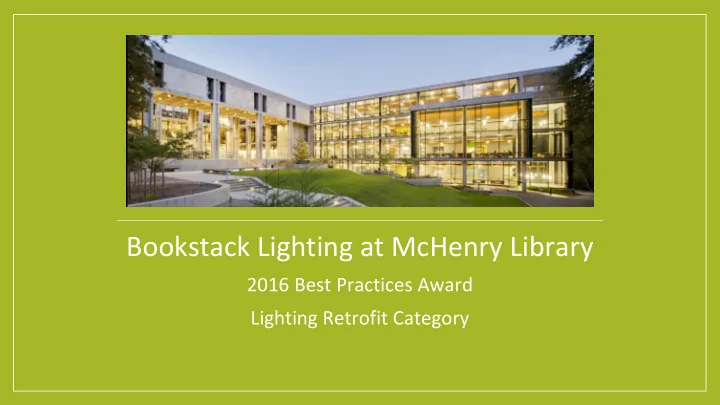

Bookstack Lighting at McHenry Library 2016 Best Practices Award Lighting Retrofit Category
Project Description ● Specifically address bookstack lighting ● Pre-existing controls = ON/OFF (no dimming) ● Projects completed in other areas of the building left stacks mostly untouched ● Scope: LED Fixture conversion; add occupancy & dimming capability
Library Bookstacks – a unique space ● Lots of light required when occupied ● Largely UN-occupied during open hours (datalogging showed ~6%-9% occupancy) ● Lights were scheduled ON for many hours before & after library’s open hours, for custodial & staff (~3 hrs/day or 1000 hrs/year) ● On/off occupancy control not an option - a large section of unlit book stacks is not a viable solution to the library staff – it looks creepy
Best Practices Demonstrated • Schedule optimization • Demand-based Illumination • Deep Green: Fixtures & Controls • Strategic sensor placement for cost savings • Collaboration
Design & Planning ● Used software simulation to aid in fixture choice ○ Lumen levels considered at work plane as well as on the faces of bookstacks ● Created a lighting fixture & control capability “wish list” ○ non-OFF, but dimmed, vacant setting ○ ability to schedule changes in control settings in advance ○ sweep on* function ○ high CRI Dialux lighting model simulation from occupant POV ○ visibility of books on all shelves
Optimized Lighting Schedule: Demand-based Illumination ● Sweep on to low/unoccupied level only during open hours ● During closed hours, low level = OFF ● Different profiles & light levels for different areas’ needs/use patterns
Deep Green: Fixtures & Controls ● Financial implications ● Design concerns - responsibility ● Constructability and scheduling impact consideration ● Occupant happiness (before, during & after project) ● … Longer payback project now would lead to lowest overall cost of ownership for the lifetime of the project.
Collaboration with Occupants • Early-on establishment of communication flow process • Key occupant: facility coordinator • Point of contact in general, but emphasis on reaching out to wider occupant/stakeholder group regularly
Project Results Total project cost: $698,449.90 Estimated annual energy savings: 407,548 kWh Estimated GHG Emissions reduction: 79.06 MTCO2e / year
Lessons Learned Getting the ball rolling is • important • Collaboration with occupants – before and AFTER is important Clarity with contractor •
Before & After
Before & After
Before & After
Recommend
More recommend